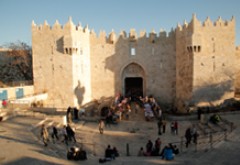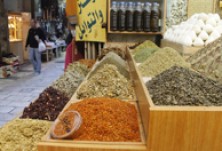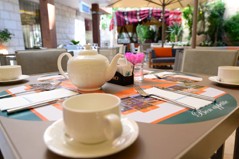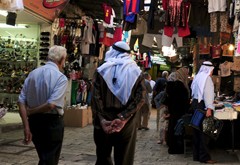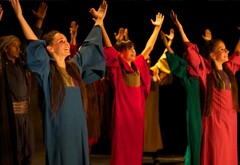Al-’Uzair Mosque is located in the center of al-‘Azariyya town, which extends over the eastern slope of the Mount of Olives on the road from Jerusalem to Jericho. This road was built during the Roman era and used until the Separation Wall was built. Al-‘Azariyya was the last stop before entering the city of Jerusalem during the Roman and Medieval eras.
Al-‘Azariyya (Bethany) and the Gospels
The town played the same role during Christ’s era, when he used to visit Jerusalem arriving from the Galilee. He used to be welcomed in al-‘Azariyya , in the home of Maria and Martha and their brother Lazarus. According to the Gospels, He performed the miracle of resurrecting the dead Lazarus from his grave after his death. Historical anecdotes and architectural evidence indicate that two churches were built in this location; the first was demolished by an earthquake in 390 AD and the second was built in the 6th century AD, as well as a mnastery for Benedictine nuns during the Byzantine era. It is likely that parts of these buildings were renovated and used during the Franks era.
Al-’Uzair (Lazarus) Mosque
After the Franks were driven out by Salad al-Din in the battle of Hittin in 1187 AD (583H), these buildings suffered from neglect and dilapidation. However, since Muslims believe in Jesus Christ as a messenger of God, as well as the miracle of resurrecting Lazarus from the dead, as it is narrated in the Holy Quran, Muslims gave special attention to the site and built a mosque after al-‘Uzair (Lazarus), naturally using some architectural remains from the site. Hence, the site comprises a mosque, a church, and a grotto.
Mosque Components
The external, humble mosque gate opens to a number of steps leading to the mosque’s open courtyard, whose level is much lower than the street. The courtyard is rectangular, surrounded by stone walls going back to different eras, as is evident from the masonry work, sizes and shapes. Its southern wall houses a simple stone prayer niche. The prayer area is accessed by a rectangular door with Ottoman engraving inscription above it. The prayer area is also rectangular and its floor is covered with rugs. Its ceiling is a barrel vault supported by a large stone pier immediately after the entrance. On the eastern part of the praying area is a rectangular tomb in Ottoman style, said to be the tomb of Lazarus. On the southern wall is a niche covered with Ottoman-style ceramic tiles, bearing various decorations. At the southern end of the praying area is an elongated niche, currently closed, but that used to lead to Lazarus’ tomb in the past. The tomb is currently accessed directly from the main road to the west of the mosque entrance.
The Church and the Grotto
The church location can be visited and architectural remains from the Byzantine and Franks era can be seen, included a traditional olive oil press showing how oil was pressed in the past, with ornamental and architectural elements in the church and its facilities. If one wishes to visit the grotto, utmost care must be taken because the steps are slippery and smooth and the route is dark and narrow, often lit by candles.

